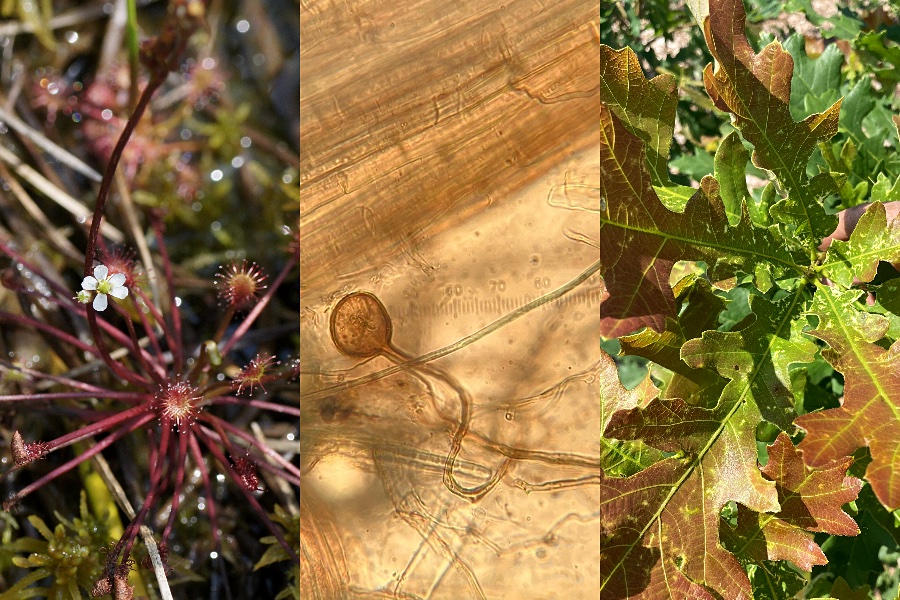
Few college students get to run their own projects at one of the world’s most celebrated research sites.
But every summer, student interns come to the U of M’s Cedar Creek Ecosystem Science Reserve (”Cedar Creek”) to do just that. Guided by mentors, they design and conduct experiments, then present their findings at an end-of-season research symposium.
In their own way, each follows in the footsteps of Raymond Lindeman (1915-42), whose graduate work at Cedar Creek’s Cedar Bog Lake laid the foundation for modern ecosystem ecology.
Four students from outside the U of M shared their work as 2023 interns—and insights they gained from their Cedar Creek experience.
The sundew’s clue
When their mentor remarked that sundews were no longer visible from the boardwalk over a Cedar Creek bog, Julia Franey and Ariel Schwartzman Miles swung into action.
With mapping software and a ground survey, they found the missing sundews further into the bog, near a lake bordered by the bog. They also found a second sundew species that had never been seen at Cedar Creek.
Their study raises the question of what factors, possibly including climate change, were at work. It also provides a starting point for future research on bog ecosystems, which store carbon and provide both flood protection and habitat for many species.
“My takeaway from this experiment was really seeing how going into the field and being curious is the backbone of scientific discovery,” says Schwartzman Miles, from Vassar College.
Franey, from the University of Massachusetts/Lowell, would tell fellow students to “Choose to study things you are excited to get up and observe every day!”
How fungi promote sustainability
To get nutrients from soil, many plants depend on “mycorrhizal” fungi that colonize their roots. The fungi absorb nutrients and trade them for energy-rich, plant-produced sugars and lipids.
At Cedar Creek, “a handful” of fields have been recovering from intense cultivation, including plowing, for different lengths of time, says Seamus McCarthy, from Macalester College. By studying fungal colonization in grass roots from these fields, he estimated how the colonization had changed over time.
“Generally, older abandoned fields exhibited a greater degree of [a certain type of] colonization than those that had been more recently abandoned,” McCarthy says. “Fungal communities are highly vulnerable to soil disturbance from plowing.”
His work shows that if left undisturbed, former farm fields can recover these fungi, which are vital for optimal health of an ecosystem.
“We can use this knowledge to preserve and restore soil ecosystems which must form the basis of any farm that wants to call itself sustainable,” McCarthy says.
His Cedar Creek experience taught him that “It's extremely important and fulfilling to learn about the knowledge held by your fellow interns and supervisors.”
Can Minnesota trees survive a warm climate?
In Iris Cessna’s experiment, bur oaks from Minnesota, Illinois, and Oklahoma were planted in sites in each of those states to compare the responses of seedlings to the three different climates.
At some point, Minnesota’s climate is expected to resemble Oklahoma’s current climate.
“Moving the trees approximates the future climatic conditions they will experience,” explains Cessna, from Wellesley College. “By planting trees from a Minnesota population in Oklahoma, we can study how the local adaptations of bur oaks create differences in their response to warmer climates.”
Besides temperature, plant ground cover—notably the vetch at Cedar Creek—and soil water content were important factors in bur oak seedlings’ survival.
Cessna’s biggest takeaway: “This experience showed me the value in my ability to think biologically and geologically simultaneously, and the importance of observation to creating scientific questions.”
Read the original story from the College of Biological Sciences
- Categories:
- Science and Technology
- Climate Change
- Research
- Sustainability






